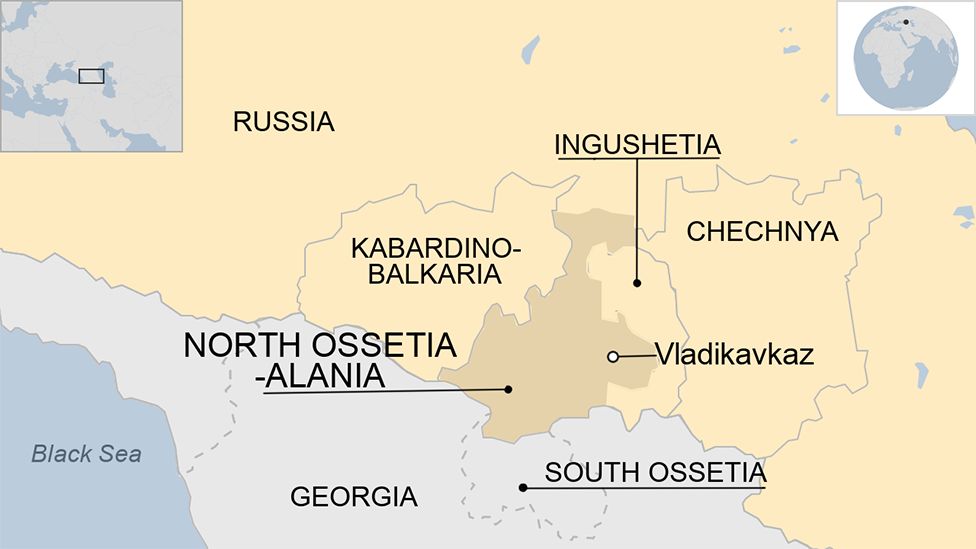North Ossetia profile
- Published

One of Russia's smallest republics, ethnic Ossetians and Russians make up most of the population of North Ossetia.
Rich in resources - including unexploited oil and gas reserves - North Ossetia is the most industrialised and urbanised republic in the North Caucasus. It also has tourism potential.
During the early 21st Century, the republic was affected by the instability afflicting other parts of the region and the spill-over from the conflict in nearby Chechnya.
- Read more country profiles - Profiles by BBC Monitoring
REPUBLIC OF NORTH OSSETIA-ALANIA: FACTS
- Capital: Vladikavkaz
- Area: 7,987 sq km
- Population: 687,000
- Languages: Russian, Ossetian
- Life expectancy: 68 years (male) 76 (female)
MEDIA
Most media outlets are owned by, or under the influence of, the republic's government. Observers say TV, radio and press news content is dominated by official information.
Press/online
- Severnaya Osetiya - owned by Ossetian parliament and government
- Osetiya Svobodny Vzglyad (Ossetian Free View) - private
- Caucasian Knot - independent regional news website, in Russian and English
- Open Caucasus Media - English-language independent regional news website
Television/radio
- GTRK Alania - state-run
- Alania Radio - entertainment-based
TIMELINE
Key events in the history of North Ossetia:
Ossetians trace their identity and language back to the Iranian-speaking medieval kingdom of Alania - a fact reflected in the republic's formal name, "Republic of North Ossetia-Alania".
8th Century - Kingdom of Alania founded
9th/10th Century - Adopts Christianity.
1236-1330 - Caucasus region conquered by the Mongols.
17th Century - Under the nominal rule of Safavid Iran.
1722-23 - Russo-Persian War: Russian gains territories in the Caucasus at the expense of Safavid Iran.
1774-1806 - Ossetia is incorporated into the Russian Empire, which founds a military outpost at Vladikavkaz and splits the region into a northern and southern half.
1920s - The territory is part of the USSR's short-lived Soviet Mountain Republic - made up of six districts including Chechnya and Ingushetia.
1936 - North Ossetia becomes an autonomous Soviet republic.
1989-92 - Ossetian-Ingush conflict. Amid the collapse of the Soviet Union, an inter-ethnic conflict in the eastern part of North Ossetia develops into a brief war between local Ingush and Ossetian paramilitary forces. Up to 600 people were killed, and up to 60,000 Ingush were were forced to flee North Ossetia for Ingushetia.
1990s - Thousands of South Ossetians flee from Georgia to North Ossetia amid ethnic tensions and violence. North Ossetia maintains strong ethnic links with the territory.
1994 - North Ossetia changes its name to the Republic of North Ossetia-Alania.
2000s onwards - An Islamist insurgency in North Caucus breaks out between Russia and militants associated with the Caucasus Emirate and, from 2015, Islamic State groups. Incidents are mostly concentrated in the North Caucasus republics of Chechnya, Dagestan, Ingushetia and Kabardino-Balkaria.
2004 - Armed attackers storm a school in the town of Beslan. In the violent end to the siege 330 people are killed; more than half of them children.
Russian President Vladimir Putin says the attackers are terrorists with links to Chechen separatists and funding from al-Qaeda. He accuses them of seeking to unleash violence across the North Caucasus in order to strike at Russia's south.
Ousted Chechen separatist president Aslan Maskhadov - killed just six months later - condemns the seizure of the school but blames Russian policy in Chechnya, describing the attackers as "madmen" seeking to avenge the Chechen people for atrocities carried out by Russians.
2008 - War breaks out in the South Ossetia region of Georgia, just over the border from North Ossetia. Russian forces drive Georgian troops out of the region.
2010 - A bomb blast blamed on Islamist insurgents kills 17 people in the regional capital Vladikavkaz.
2017 - Russia's FSB security service kills four IS militants in a counter-terrorism operation south of Vladikavkaz near the border with Georgia.
- Published25 March
- Published28 August 2023
- Published28 August 2023
- Published28 August 2023
- Published28 August 2023
- Published30 October 2023
- Published28 August 2023
- Published28 August 2023
- Published30 January